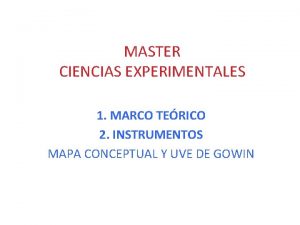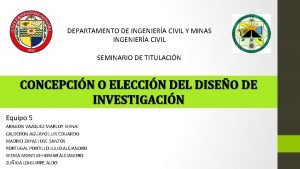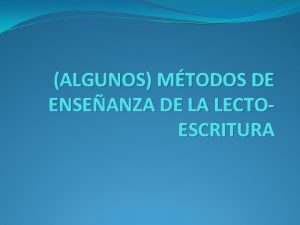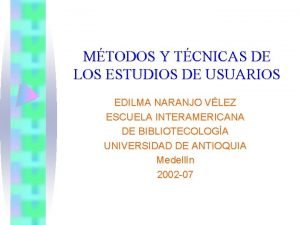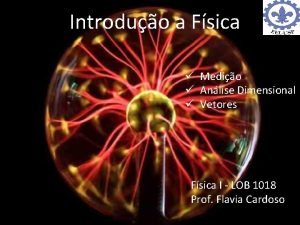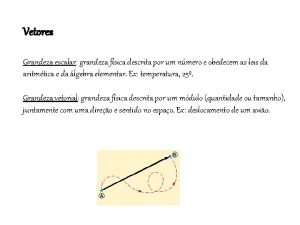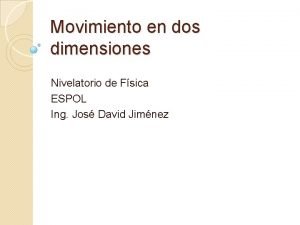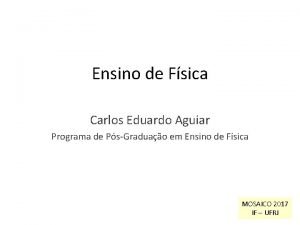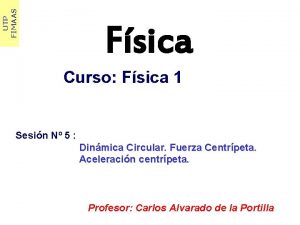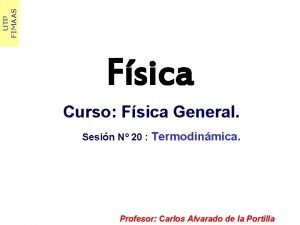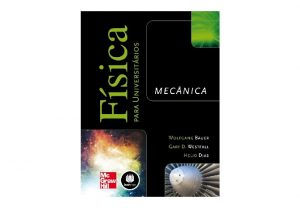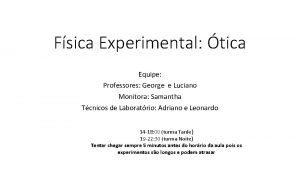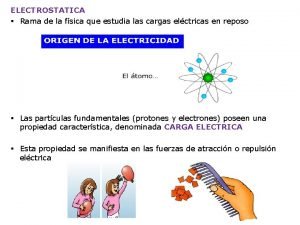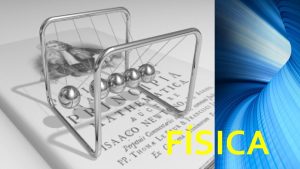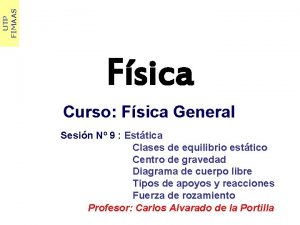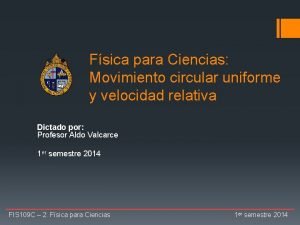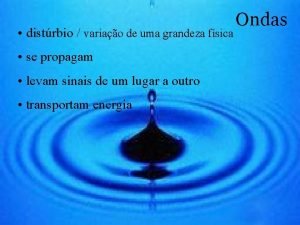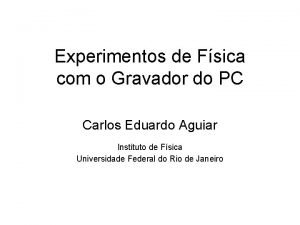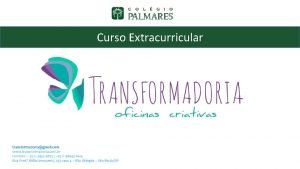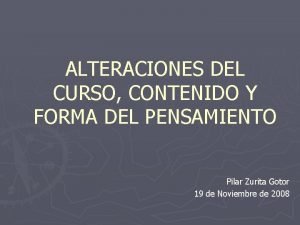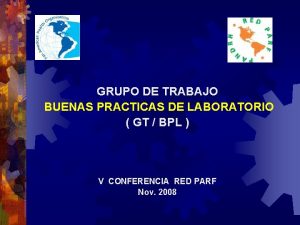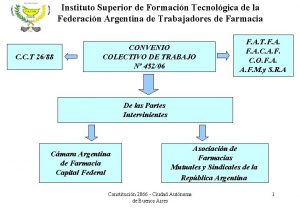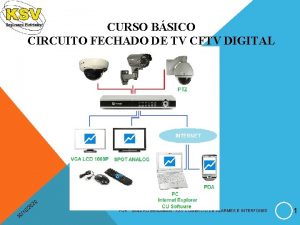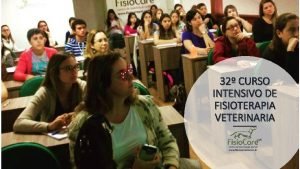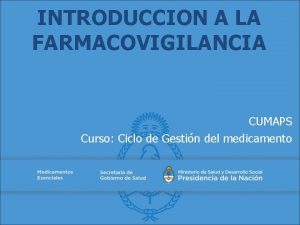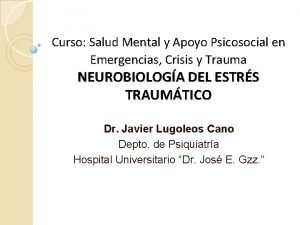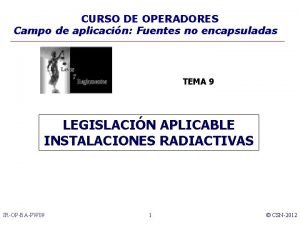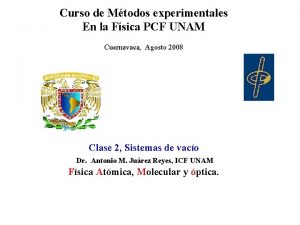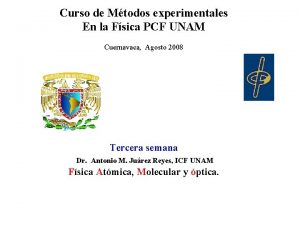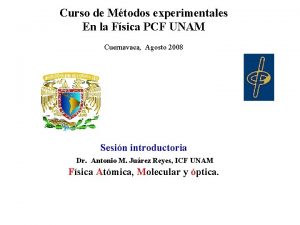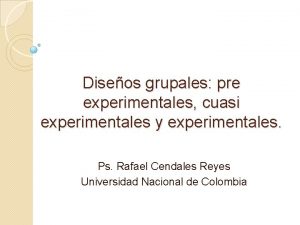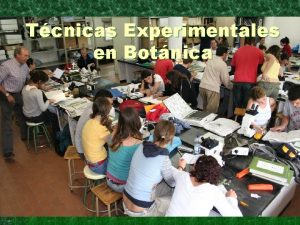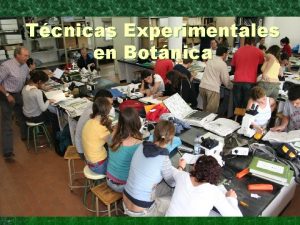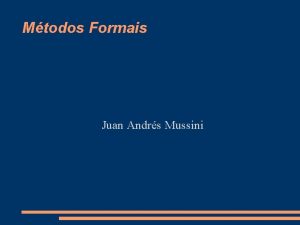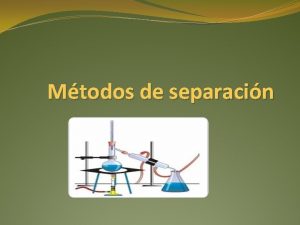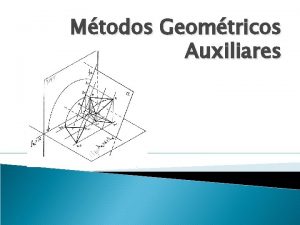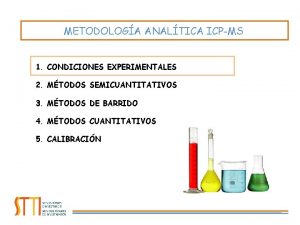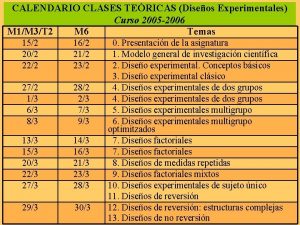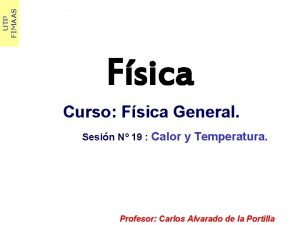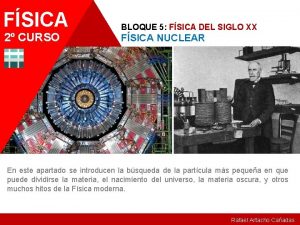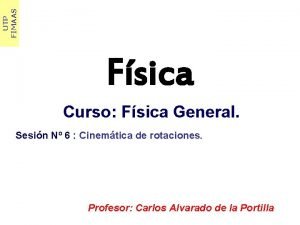Curso de Mtodos experimentales En la Fsica PCF















































































- Slides: 79

Curso de Métodos experimentales En la Física PCF UNAM Cuernavaca, Agosto 2008 cuarta semana Dr. Antonio M. Juárez Reyes, ICF UNAM Física Atómica, Molecular y óptica.

Cuernavaca, Agosto 2008 TEMARIO PARTE 1 I. - Instrumentos y conceptos básicos (Toño, 5 semanas) I. 1. - Conceptos básicos de instrumentación -Conceptos generales de seguridad en el laboratorio (eléctrica, de gases comprimidos, láseres y químicos. --El proceso de medida y asignación de incertidumbres. I. 2. - Instrumentos básicos 2. 1 sistemas de vacío. -Conductancia, velocidad de bombeo, viscosidad, -bombas: Rotatorias, de diafragma, difusoras, turbo, de sublimación, ionicas. razón de compresión en bombas, - transductores de presión, pirani, Bayer Alpert, Baratrón, análisis de gases residuales. 2. 2 Instrumentos básicos de electrónica: -osciloscopios, generadores de señales, electrómetros, 2. 3 Instrumentos avanzados -Amplificador Lock In -Integrador Boxcar -Monocromadores

Cuernavaca, Agosto 2008 I. 3. - Conceptos generales de láseres y fuentes de luz: - Cavidades, ganancia y finesa - Etalones de Fabri Perot, elementos ópticos - Láseres pulsados de nitróngeno, Nd: YAG, pulsadores del tipo Q-Switch, láseres de diodo de cavidad extendida, -Otras fuentes de luz: sincrotrónesy Free electron Lasers, I. 4. -Conceptos generales de diseño: herramientas de dibujo, herramientas de simulación de circuitos, criterios generales de diseño de piezas asociadas a instrumentación científica. El taller de electrónica y el taller de mecánica del ICF 1. 5 Elección del proyectos semestrales de instrumentación

Cuernavaca, Agosto 2008 I. 3. - Conceptos generales de láseres y fuentes de luz: -Cavidades, tipos de resonadores, ganancia y finesa -Etalones de Fabri Perot, elementos ópticos, -Componentes ópticas especiales ( moduladores optoacústicos, placas de media y cuarto de onda, diodos faraday -Láseres pulsados de nitróngeno, Nd: YAG, pulsadores del tipo QSwitch, láseres de diodo de cavidad extendida, laseres de tintes -Otras fuentes de luz: sincrotrónesy Free electron Lasers,

Cuernavaca, Agosto 2008 Light amplificated by stimulated emission of radiation (LASER) -General layout -1 Active media -2 External pump source -3 and 4 optical resonator -5 Laser light

Cuernavaca, Agosto 2008 Light amplificated by stimulated emission of radiation (LASER) -General layout -1 Active media -2 External pump source -3 and 4 optical resonator -5 Laser light Lasing occures whenever the laser threshold is reached The threshold of a laser is the state where the small-signal gain just equals the resonator losses. This is the case for a certain pump power (the threshold pump power), or (for electrically pumped lasers) a certain threshold current. Significant power output, good power efficiency and stable, low-noise performance requires operation well above threshold.

Cuernavaca, Agosto 2008 Light amplificated by stimulated emission of radiation (LASER) -General layout -1 Active media -2 External pump source -3 and 4 optical resonator -5 Laser light Lasing occures whenever the laser threshold is reached The threshold pump power of a laser is the value of the pump power at which the laser threshold is just reached. At this point, the smallsignal gain equals the losses of the laser resonator. A similar threshold exists for some other types of light sources, such as Raman lasers and optical parametric oscillators.

Cuernavaca, Agosto 2008 Light amplificated by stimulated emission of radiation (LASER) -General layout -1 Active media -2 External pump source -3 and 4 optical resonator -5 Laser light Lasing occures whenever the laser threshold is reached

Cuernavaca, Agosto 2008 Light amplificated by stimulated emission of radiation (LASER) -General layout -1 Active media -2 External pump source -3 and 4 optical resonator -5 Laser light Within the context of laser physics, a laser gain medium is a medium which can amplify the power of light (typically in the form of a light beam). Such a gain medium is required in a laser to compensate for the resonator losses, and is also called an active laser medium. It can also be used for application in an optical amplifier. The term gain refers to the amount of amplification.

Cuernavaca, Agosto 2008 Light amplificated by stimulated emission of radiation (LASER) -General layout -1 Active media -2 External pump source -3 and 4 optical resonator -5 Laser light Types of Laser Gain Media There a variety of very different gain media; the most common of them are: Certain direct-bandgap semiconductors such as Ga. As, Al. Ga. As( aluminium Galium arsenide), or In. Ga. As(aluminium Galium arsenide), are typically pumped with electrical currents, these lasers are often in the form of quantum wells. A quantum well is a thin layer which can confine (quasi-)particles (typically electrons or holes) in the dimension perpendicular to the layer surface, whereas the movement in the other dimensions is not restricted. The confinement is a quantum effect. It has profound effects on the density of states for the confined particles. For a quantum well with a rectangular profile, the density of states is constant within certain energy intervals. [1]T. Makino, “Analytical formulas for the optical gain of quantum wells”, IEEE J. Quantum Electron. 32, 493 (1995) [2]P. S. Zory (ed. ), Quantum Well Lasers – Principles and Applications, Academic Press, New York (1993)

Cuernavaca, Agosto 2008 Light amplificated by stimulated emission of radiation (LASER) -General layout -1 Active media -2 External pump source -3 and 4 optical resonator -5 Laser light Types of Laser Gain Media …Certain laser crystals and glasses such as Nd: YAG (neodymiumdoped yttrium aluminum garnet → YAG lasers), Yb: YAG (ytterbium doped YAG), Yb: glass, Er: YAG (erbium-doped YAG), or Ti: sapphire are used in the form of solid pieces (→ bulk lasers) or optical glass fibers (→ fiber lasers, fiber amplifiers). These crystals or glasses are doped with some laser-active ions (in most cases trivalent rare earth ions, sometimes transition metal ions) and optically pumped. Lasers based on such media are sometimes called doped insulator lasers.

Cuernavaca, Agosto 2008 Light amplificated by stimulated emission of radiation (LASER) -General layout -1 Active media -2 External pump source -3 and 4 optical resonator -5 Laser light Types of Laser Gain Media There are ceramic gain media, which are also normally doped with rare earth ions. Laser dyes are used in dye lasers, typically in the form of liquid solutions. Gas lasers are based on certain gases or gas mixtures, typically pumped with electrical discharges (e. g. in CO 2 lasers and excimer lasers). More exotic gain media are chemical gain media (converting chemical energy to optical energy), nuclear pumped media, and undulators in free electron lasers (transferring energy from a fast electron beam to a light beam).

Cuernavaca, Agosto 2008 -General layout -1 Active media -2 External pump source -3 and 4 optical resonator -5 Laser light Types of Laser Gain Media In most cases, the physical origin of the amplification process is stimulated emission, where photons of the incoming beam trigger the emission of additional photons in a process where e. g. initially excited laser ions enter a state with lower energy. Here, there is a distinction between four-level and three-level gain media.

Cuernavaca, Agosto 2008 -General layout -1 Active media -2 External pump source -3 and 4 optical resonator -5 Laser light Types of Laser Gain Media four-level and three-level gain media. In a three-level system, the laser transition ends on the ground state. The unpumped gain medium exhibits strong absorption on the laser transition. Only by pumping more than half of the ions (or atoms) into the upper laser level do a population inversion and consequently net laser gain result; the threshold pump power is thus fairly high.

Cuernavaca, Agosto 2008 -General layout -1 Active media -2 External pump source -3 and 4 optical resonator -5 Laser light Types of Laser Gain Media four-level and three-level gain media. An example of a three-level laser medium is ruby (Cr 3+: Al 2 O 3)

Cuernavaca, Agosto 2008 -General layout -1 Active media -2 External pump source -3 and 4 optical resonator -5 Laser light Types of Laser Gain Media four-level and three-level gain media. A lower threshold pump power can be achieved with a four-level laser medium, where the lower laser level is well above the ground state and is quickly depopulated e. g. by multiphonon transitions. Ideally, no appreciable population density in the lower laser level can occur even during laser operation. The gain usually rises linearly with the absorbed pump power.

Cuernavaca, Agosto 2008 -General layout -1 Active media -2 External pump source -3 and 4 optical resonator -5 Laser light Types of Laser Gain Media four-level and three-level gain media. The most popular four-level solid-state gain medium is Nd: YAG. All lasers based on neodymium-doped gain media, except those operated on the ground-state transition around 0. 9– 0. 95 μm, are four-level lasers.

Cuernavaca, Agosto 2008 -General layout -1 Active media -2 External pump source -3 and 4 optical resonator -5 Laser light Types of Laser Gain Media four-level and three-level gain media. A quasi-three-level laser medium is the intermediate situation, where the lower laser level is so close to the ground state that an appreciable population in that level occurs in thermal equilibrium at the operating temperature. As a consequence, the unpumped gain medium causes some loss at the laser wavelength, and lasing is reached only for some finite pump intensity. For higher pump intensities, there is gain, as required for laser operation.

Cuernavaca, Agosto 2008 -General layout -1 Active media -2 External pump source -3 and 4 optical resonator -5 Laser light Types of Laser Gain Media Figure 2: Gain and absorption (negative gain) of erbium (Er 3+) ions in germano-alumino-silicate glass for excitation levels from 0 to 100% in steps of 20%. Strong three-level behavior (with transparency reached only for > 50% excitation) occurs at 1530 nm. At longer wavelengths (e. g. 1580 nm), a lower excitation level is required for obtaining gain, but the maximum gain is smalle

Cuernavaca, Agosto 2008 -General layout -1 Active media -2 External pump source -3 and 4 optical resonator -5 Laser light Types of Laser Gain Media Relevant Physical Properties of Laser Gain Media A great variety of physical properties of a gain medium can be relevant for use in a laser. The desirable properties include: 1. - a laser transition in the desired wavelength region, preferably with the maximum gain occurring in this region 2. - a high transparency of the host medium in this wavelength region a pump wavelength for which a good pump source is available (in case of an optically pumped laser); 3. - efficient pump absorption a suitable upper-state lifetime: long enough for Q-switching applications, short enough if fast modulation of the power is required a high quantum efficiency, obtained via a low prevalence for quenching effects, excited-state absorption and the like, but also possibly by strong enough beneficial effects such as certain mul -phonon transitions or energy transfers 4. - ideally, four-level behavior, because quasi-three-level behavior introduces various additional constraints 5. - robustness and a long lifetime, chemical stability

Bibliography Cuernavaca, Agosto 2008 -General layout -1 Active media -2 External pump source -3 and 4 optical resonator -5 Laser light Types of Laser Gain Media References P. P. Sorokin and M. J. Stevenson, “Stimulated infrared emission from trivalent uranium”, Phys. Rev. Lett. 5 (12), 557 (1960) (the first four-level laser) W. P. Risk, “Modeling of longitudinally pumped solid-state lasers exhibiting reabsorption losses”, J. Opt. Soc. Am. B 5 (7), 1412 (1988)

Cuernavaca, Agosto 2008 Light amplificated by stimulated emission of radiation (LASER) -General layout -1 Active media -2 External pump source (optical pumping) -3 and 4 optical resonator -5 Laser light

Cuernavaca, Agosto 2008 Light amplificated by stimulated emission of radiation (LASER) -General layout -1 Active media -2 External pump source (optical pumping) -3 and 4 optical resonator -5 Laser light Definition: electronically exciting a medium with light, or specifically populating certain electronic levels Optical pumping processes can often be described with rate equation modeling. However, this disregards some aspects of the quantum nature of the atom–photon interaction. More comprehensive physical models exist which can also describe coherent phenomena such as Rabi oscillations.

Cuernavaca, Agosto 2008 Light amplificated by stimulated emission of radiation (LASER) -General layout -1 Active media -2 External pump source (optical pumping) -3 and 4 optical resonator -5 Laser light As an example, consider the dynamics of an erbium-doped gain medium, such as used in, e. g. , erbium-doped fiber amplifiers. Ip Intensidad de bombeo Is Intensidad de luz estimulada

Cuernavaca, Agosto 2008 Common types of optical pump sources are: discharge lamps (→ lamp-pumped lasers) laser diodes (→ diode-pumped lasers) other types of lasers or laser sources: Examples of the latter case are titanium–sapphire lasers pumped with frequency-doubled solid-state lasers, and dye lasers pumped with gas lasers.

Cuernavaca, Agosto 2008 Pump light for optical pumping has to fulfill a number of requirements: The optical spectrum of the pump light must be suitable. Ideally, all the photons should have a suitable energy for the wanted electronic transitions. However, certain laser-active ions (e. g. neodymium ions) can also be pumped with fairly broadband light e. g. for flash lamps or arc lamps, albeit with a strongly reduced power conversion efficiency. The pump intensity must be sufficiently high. Lasers are often pumped with intensities of the order of the saturation intensity of the laser transition, but fourlevel lasers can also be operated with lower pump intensities. Depending on the geometry, there can be more or less stringent requirements on the pump beam quality. This applies mostly to end-pumped lasers. In some cases, the polarization state of the pump light is also important. Some nonisotropic gain media, such as Nd: YVO 4, exhibit very different levels of absorption for different polarization directions. In spectroscopy, circularly polarized light is sometimes required for populating certain hyperfine levels. The intensity noise of the pump source should not be too large, because at least its low-frequency components can be transferred to the laser output.

Cuernavaca, Agosto 2008 Light amplificated by stimulated emission of radiation (LASER) -General layout -1 Active media -2 External pump source (optical pumping) -3 and 4 optical resonator -5 Laser light [1] M. Peroni and M. Tamburrini, “Gain in erbium-doped fiber amplifiers: a simple analytical solution for the rate equations”, Opt. Lett. 15 (15), 842 (1990) [2] C. R. Giles and E. Desurvire, “Modeling erbium-doped fiber amplifiers”, J. Lightwave Technol. 9 (2), 271 (1991) [3] R. Paschotta et al. , “Characterization and modeling of thulium: ZBLAN blue upconversion fiber lasers”, J. Opt. Soc. Am. B 14 (5), 1213 (1997)

Cuernavaca, Agosto 2008 Light amplificated by stimulated emission of radiation (LASER) -General layout -1 Active media -2 External pump source (optical pumping) -3 and 4 optical resonator (optical cavity) -5 Laser light

Cuernavaca, Agosto 2008 Light amplificated by stimulated emission of radiation (LASER) -General layout -1 Active media -2 External pump source (optical pumping) -3 and 4 optical resonator (optical cavity) -5 Laser light An optical resonator (or resonant optical cavity) is an arrangement of optical components which allows a beam of light to circulate in a closed path. Such resonators can be made in very different forms. Depending upon the geometry an optical cavity or optical resonator forms a standing wave cavity resonator for light waves.

Cuernavaca, Agosto 2008 An optical resonator can be made from bulk optical components, as shown in the next page , or as a waveguide resonator, where the light is guided rather than sent through free space. . Bulk-optical resonators are used e. g. for solid-state bulk lasers. The transverse mode properties depend on the overall setup (including the length of air spaces), and mode sizes can vary significantly along the resonator. In some cases, the mode properties are also significantly influenced by effects such as thermal lensing. Waveguide resonators are often made with optical fibers (e. g. for fiber lasers) or in the form of integrated optics. The transverse mode properties (see below) are determined by the local properties of the waveguide. There also mixed types of resonators, containing both waveguides and parts with free-space optical propagation. Such resonators are used e. g. in some fiber lasers, where bulk-optical components need to be inserted into the laser resonator.

Cuernavaca, Agosto 2008 Linear versus Ring . Linear (or standing-wave) resonators (Figure 1, top) are made such that the light bounces back and forth between two end mirrors. For continuously circulating light, there always counterpropagating waves, which interfere with each other to form a standing-wave pattern. In ring resonators (Figure 1, bottom), light can circulate in two different directions. A ring resonator has no end mirrors. Figure 1: A simple linear optical resonator with a curved folding mirror (top) and a four-mirror bow-tie ring resonator (bottom).

Cuernavaca, Agosto 2008 During a resonator round trip, light experiences various physical effects which change its spatial distribution: diffraction, focusing or defocusing effects of optical elements (sometimes involving optical nonlinearities), in special cases also gain guiding, saturable absorption, etc. Some important differences between linear resonators and ring resonators are: . In a ring resonator, light can circulate in two different directions. If there is an output coupler mirror, this leads to two different output beams. A linear resonator with the output coupler at an end does not exhibit this phenomenon. An optical component within a resonator is hit by the light once per round trip in the case of a ring laser, and twice per round trip in a linear resonator (except for the end mirrors).

Cuernavaca, Agosto 2008 During a resonator round trip, light experiences various physical effects which change its spatial distribution: diffraction, focusing or defocusing effects of optical elements (sometimes involving optical nonlinearities), in special cases also gain guiding, saturable absorption, etc. Some important differences between linear resonators and ring resonators are: . … When light is injected into a linear resonator via a partially transparent mirror, reflected light can propagate back to the light source. This is not the case for a ring resonator. Therefore, ring resonators are sometimes preferred for resonant frequency doubling with a laser source which is sensitive against optical feedback. A linear bulk resonator can have two stability zones (see below), e. g. for variation of the dioptric power of an internal lens, or of a resonator arm length. A ring resonator has only one stability zone.

Cuernavaca, Agosto 2008 During a resonator round trip, light experiences various physical effects which change its spatial distribution: diffraction, focusing or defocusing effects of optical elements (sometimes involving optical nonlinearities), in special cases also gain guiding, saturable absorption, etc. Some important differences between linear resonators and ring resonators are: . The non-normal incidence of light on every resonator mirror of a ring resonator causes astigmatism if a resonator mirror has a curved surface. A bow-tie ring resonator geometry is often used to minimize astigmatism by keeping the incidence angles small. Monolithic ring resonators with high Q factor can exploit total internal reflection at all surfaces, and thus may not require any dielectric mirror.

Cuernavaca, Agosto 2008 Examples of optical cavities Depending upon its geometry, optical resonators present different stability properties…. What is stability?

Cuernavaca, Agosto 2008 Definition of stability zones : parameter regions of an optical resonator where the beam is geometrically stable When a parameter of a laser resonator (optical cavity) such as an arm length or the dioptric power (inverse focal length) of the focusing element in the resonator is varied, the resonator may go through one (for ring resonators) or two (for standing-wave resonators) stability zones. In a purely geometric sense, stability means that a ray injected into the optical system will stay at a finite distance from the axis even after many round trips.

Cuernavaca, Agosto 2008 Definition of stability zones : parameter regions of an optical resonator where the beam is geometrically stable When a parameter of a laser resonator (optical cavity) such as an arm length or the dioptric power (inverse focal length) of the focusing element in the resonator is varied, the resonator may go through one (for ring resonators) or two (for standing-wave resonators) stability zones. In a purely geometric sense, stability means that a ray injected into the optical system will stay at a finite distance from the axis even after many round trips.

Cuernavaca, Agosto 2008 Definition of stability zones : parameter regions of an optical resonator where the beam is geometrically stable When a parameter of a laser resonator (optical cavity) such as an arm length or the dioptric power (inverse focal length) of the focusing element in the resonator is varied, the resonator may go through one (for ring resonators) or two (for standing-wave resonators) stability zones. Only certain ranges of values for R 1, R 2, and L produce stable resonators in which periodic refocussing of the intracavity beam is produced. If the cavity is unstable, the beam size will grow without limit, eventually growing larger than the size of the cavity mirrors and being lost. By using methods such as ray transfer matrix analysis, it is possible to calculate a stability criterion:

Cuernavaca, Agosto 2008 Stability criterion Values which satisfy the inequality correspond to stable resonators. The stability can be shown graphically by defining a stability parameter, g for each mirror:

Cuernavaca, Agosto 2008 Interms of g, the stability zones look like:

Cuernavaca, Agosto 2008 Modes: In general, radiation patterns which are reproduced on every round-trip of the light through the resonator are the most stable, and these are the eigenmodes, known as the modes, of the resonator. Resonator modes are the modes of an optical resonator (cavity), i. e. field distributions which reproduce themselves (apart from a possible loss of power) after one round trip. They can exist whether or not the resonator is geometrically stable, but the mode properties of unstable resonators are fairly sophisticated. In the following, only modes of stable resonators are considered

Cuernavaca, Agosto 2008 Examples of optical cavities Resonator modes can be divided into two types: longitudinal modes, which differ in frequency from each other; and transverse modes, which may differ in both frequency and the intensity pattern of the light. The basic, or fundamental transverse mode of a resonator is a Gaussian beam.

Cuernavaca, Agosto 2008 In the simplest case of a resonator containing only parabolic mirrors and optically homogeneous media, the resonator modes (cavity modes) are Hermite–Gaussian modes. The simplest of those are the Gaussian modes, where the field distribution is defined by a Gaussian function (→ Gaussian beams). The evolution of the beam radius and the radius of curvature of the wavefronts is determined by the details of the resonator. As an example, Figures 1 and 2 show the Gaussian resonator modes for two versions of a simple resonator with a plane mirror, a laser crystal, and a curved end mirror. For a more strongly curved end mirror (Figure 2), the mode radius on the left mirror becomes smaller.

Cuernavaca, Agosto 2008 The simplest mode is the Gaussian mode, which has a complex amplitude described by the cylindrical equation: With solution in terms of intensity:

Cuernavaca, Agosto 2008 Hermite Gaussian modes. The Gaussian mode is a specific case of the more generalized Hermite-Gaussian (HG) modes. The HG modes are also referred to as Transverse Electro-Magnetic, or TEM. A TEM mode is described as TEMmn, where m and n are the indices of the mode. m refers to the number of intensity minima in the direction of the electric field oscillation, and n refers to the number of minima in the direction of the magnetic field oscillation.

Cuernavaca, Agosto 2008 Hermite Gaussian modes. The Gaussian mode is a specific case of the more generalized Hermite-Gaussian (HG) modes. The HG modes are also referred to as Transverse Electro-Magnetic, or TEM. A TEM mode is described as TEMmn, where m and n are the indices of the mode. m refers to the number of intensity minima in the direction of the electric field oscillation, and n refers to the number of minima in the direction of the magnetic field oscillation.

Cuernavaca, Agosto 2008 Hermite Gaussian modes. Example: HG 02 mode The mathematical equation for its complex amplitude is

Cuernavaca, Agosto 2008 In addition to the Gaussian modes, a resonator also has higher-order modes with more complicated intensity distributions


¿What can you do With them. . Example of a box For an atom

Cuernavaca, Agosto 2008 Other cool modes: Laguerre-Gaussian Modes LG modes, like the Gaussian mode, are circularly symmetric. However, all LG modes except LG 00 are hollow. Their key feature is the presence of a screw phase dislocation, which means that is has orbital angular momentum. One cool application of this is the transfer of this momentum to a particle, making it spin. This screw phase dislocation is also the origin of the hollow center of an LG beam, since that type of phase dislocation appears as a dark spot. An LG mode is described by the equation (with symbols defined as they were for HG modes):

Cuernavaca, Agosto 2008 Other cool modes: Laguerre-Gaussian Modes

How complex can They get?


Cuernavaca, Agosto 2008 Light amplificated by stimulated emission of radiation (LASER) -General layout -1 Active media -2 External pump source -3 and 4 optical resonator -5 Laser light

Cuernavaca, Agosto 2008 -5 Laser light ( IMPORTANT DEFINITIONS) -Coherence length and coherence time -Linewidth -Power Coherence (time): a measure of temporal coherence, expressed as the time over which the field correlation decays The coherence time can be used for quantifying the degree of temporal coherence of light. In coherence theory, it is essentially defined as the time over which the field correlation function decays. This correlation (or coherence) function is where E(t) is the complex electric field at a certain location. This function is 1 for = 0 and usually decays monotonically for larger time delays

Cuernavaca, Agosto 2008 Coherence (time): a measure of temporal coherence, expressed as the time over which the field correlation decays The coherence time can be used for quantifying the degree of temporal coherence of light. In coherence theory, it is essentially defined as the time over which the field correlation function decays. This correlation (or coherence) function is For an arbitrary shape of this function, the coherence time can be defined by

Cuernavaca, Agosto 2008 Instead of the coherence time, it is common to specify the coherence length, which is simply the coherence times the vacuum velocity of light, and thus also quantifies temporal (rather than spatial) coherence. [1]B. E. A. Saleh and M. C. Teich, Fundamentals of Photonics, John Wiley & Sons, Inc. , New York (1991)

Cuernavaca, Agosto 2008 The reason for often using the term coherence length instead of coherence time is that the optical time delays involved in some experiment are often determined by optical path lengths. Lasers, particularly single-frequency solid-state lasers, can have very long coherence lengths, e. g. 9. 5 km for a Lorentzian spectrum with a linewidth of 10 k. Hz. The coherence length is limited by phase noise which can result from, e. g. , spontaneous emission in the gain medium. [1]B. E. A. Saleh and M. C. Teich, Fundamentals of Photonics, John Wiley & Sons, Inc. , New York (1991)

Cuernavaca, Agosto 2008 The coherence time is intimately linked with the linewidth of the radiation, i. e. , the width of its spectrum. In the case of an exponential coherence decay as above, the spectrum has a Lorentzian shape, and the (full width at half-maximum) linewidth is

Cuernavaca, Agosto 2008 A finite linewidth arises from phase noise if the phase undergoes unbounded drifts, as is the case for free-running oscillators. Drifts of the resonator length (e. g. related to 1 / f noise) can further contribute to the linewidth and can make it dependent on the measurement time. This shows that the linewidth alone, or even the linewidth complemented with a spectral shape (line shape), does by far not provide full information on the spectral purity of laser light. (This is particularly the case for lasers with dominating low-frequency phase noise. )

Cuernavaca, Agosto 2008 For simple cases, the fundamental limit for the laser linewidth arising from quantum noise was calculated by Schawlow and Townes [1] even before the first laser was experimentally demonstrated. According to the Schawlow– Townes equation [1]A. L. Schawlow and C. H. Townes, “Infrared and optical masers”, Phys. Rev. 112 (6), 1940 (1958) (contains the famous Schawlow–Townes equation) the linewidth (FWHM) is proportional to the square of the resonator bandwidth divided by the output power (assuming that there are no parasitic resonator losses). The article on the Schawlow–Townes linewidth contains a more practical form of the equation.

Cuernavaca, Agosto 2008 Measurement of Laser Linewidth A laser linewidth can be measured with a variety of techniques: For large linewidths (e. g. > 10 GHz, as obtained when multiple modes of the laser resonator are oscillating), traditional techniques of optical spectrum analysis, e. g. based on diffraction gratings, are suitable. Another technique is to convert frequency fluctuations to intensity fluctuations, using a frequency discriminator, which can be, e. g. , an unbalanced interferometer or a high-finesse reference cavity. For single-frequency lasers, the self-heterodyne technique is often used, which involves recording a beat note between the laser output and a frequency-shifted and delayed version of it. For sub-kilohertz linewidths, the ordinary self-heterodyne technique usually becomes impractical, but it can be extended by using a recirculating fiber loop with an internal fiber amplifier.

Cuernavaca, Agosto 2008 Measurement of Laser Linewidth Very high resolution can also be obtained by recording a beat note between two independent lasers, where either the reference laser has significantly lower noise than the device under test, or both lasers have similar performance. This method is conceptually very simple and reliable, but the requirement of a second laser (operating at a nearby optical frequency) can be inconvenient. If linewidth measurements are required in a wide spectral range, a frequency comb source can be very useful. Exercise: What are the linewidths of the lasers in the lab? How do they compare To the natural linewidth of, say Rubidium ( isotope 85) and to the doppler broadening

Cuernavaca, Agosto 2008 -5 Laser light ( IMPORTANT DEFINITIONS) -Coherence length and coherence time -Linewidth -Power The linewidth (or line width) of a laser, typically a single-frequency laser, is the width (typically the full width at half-maximum, FWHM) of its optical spectrum. More precisely, it is the width of the power spectral density of the emitted electric field in terms of frequency, wavenumber or wavelength.

Cuernavaca, Agosto 2008 -5 Laser light ( IMPORTANT DEFINITIONS) -Coherence length and coherence time -Linewidth -Power Or, to be more precise, power spectral density Definition: optical power or noise power per unit frequency Interval In optics, power spectral densities (also sometimes just called power densities) occur basically in two different forms: optical power spectral densities, defined as the optical power per optical frequency (or wavelength) interval, e. g. specified in m. W/THz or m. W/nm

Cuernavaca, Agosto 2008 Or, to be more precise, power spectral density Definition: optical power or noise power per unit frequency Interval In optics, power spectral densities (also sometimes just called power densities) occur basically in two different forms: optical power spectral densities, defined as the optical power per optical frequency (or wavelength) interval, e. g. specified in m. W/THz or m. W/nm

Cuernavaca, Agosto 2008 Or, to be more precise, power spectral density Definition: optical power or noise power per unit frequency Interval Note the units in The scale!!

Cuernavaca, Agosto 2008 To keep the power spectral density of a laser narrow And stable, one needs to stabilize a laser ( they tend to be very sensitive to changes in temperature ( cavities Change length, media change properties. . Etc) To keep a laser stable, one needs to do tricks

Cuernavaca, Agosto 2008 Stabilization of Lasers Active Laser Stabilization Active stabilization schemes usually involve some kind of electronic feedback system, where fluctuations of some parameters are converted to an electronic signal, which is then used to act on the laser in some way.

Cuernavaca, Agosto 2008 Stabilization of Lasers The output power of a laser may be stabilized with a scheme as shown in Figure 1. The laser power is monitored with a photodiode and corrected e. g. via control of the pump power or the losses in or outside the laser resonator. In this way, both spiking after turn-on and the intensity noise under steady-state conditions can be reduced.

Cuernavaca, Agosto 2008 Stabilization of Lasers Passive schemes do not involve electronics and are based on purely optical effects. Examples are: The frequency of a laser can be stabilized via optical feedback from a stable reference cavity. Synchronization of two mode-locked lasers is possible via cross-phase modulation in a Kerr medium, in which the intracavity pulses of both lasers meet.

Cuernavaca, Agosto 2008 Stabilization of Lasers Other schemes Examples are: The frequency of a laser can be stabilized via optical feedback from a stable reference cavity. Synchronization of two mode-locked lasers is possible via cross-phase modulation in a Kerr medium, in which the intracavity pulses of both lasers meet. ( in spanish, please!)

Cuernavaca, Agosto 2008 Stabilization of Lasers Other schemes. Examples are: The frequency of a laser can be stabilized via optical feedback from a stable reference cavity. Synchronization of two mode-locked lasers is possible via cross-phase modulation in a Kerr medium, in which the intracavity pulses of both lasers meet. ( in spanish, please!)

Cuernavaca, Agosto 2008 Stabilization of Lasers A reference cavity is a passive optical resonator (resonant cavity) which is used as a kind of fly-wheel oscillator (short-term frequency reference) in an optical frequency standard. The optical frequency of a single-frequency laser (or of a single line of the output of a mode-locked laser) can be stabilized to the frequency of a resonance of the reference cavity, effectively transferring the higher frequency stability of the cavity to the laser. Such stabilization or frequency locking can be achieved e. g. with an electronic feedback system based on the Pound–Drever–Hall method or the Hänsch–Couillaud method.

Cuernavaca, Agosto 2008 Next week: I. 3. - Conceptos generales de láseres y fuentes de luz: -Cavidades, ganancia y finesa -Etalones de Fabri Perot, elementos ópticos, Componentes ópticas especiales ( moduladores optoacústicos, placas de media y cuarto de onda, diodos faraday -Láseres pulsados de nitróngeno, Nd: YAG, pulsadores del tipo Q Switch, láseres de diodo de cavidad extendida, laseres de tintes -Otras fuentes de luz: sincrotrónesy Free electron Lasers,

Cuernavaca, Agosto 2008 I. 3. - Conceptos generales de láseres y fuentes de luz: -Cavidades, ganancia y finesa -Etalones de Fabri Perot, elementos ópticos, -Componentes ópticas especiales ( moduladores optoacústicos, placas de media y cuarto de onda, diodos faraday -Láseres pulsados de nitróngeno, Nd: YAG, pulsadores del tipo QSwitch, láseres de diodo de cavidad extendida, laseres de tintes -Otras fuentes de luz: sincrotrónesy Free electron Lasers,

Cuernavaca, Agosto 2008 I. 3. - Conceptos generales de láseres y fuentes de luz: -Cavidades, tipos de resonadores, ganancia y finesa -Etalones de Fabri Perot, elementos ópticos, -Componentes ópticas especiales ( moduladores optoacústicos, placas de media y cuarto de onda, diodos faraday -Láseres pulsados de nitróngeno, Nd: YAG, pulsadores del tipo QSwitch, láseres de diodo de cavidad extendida, laseres de tintes -Otras fuentes de luz: sincrotrónesy Free electron Lasers,

Cuernavaca, Agosto 2008 I. 3. - Conceptos generales de láseres y fuentes de luz: -Cavidades, tipos de resonadores, ganancia y finesa -Etalones de Fabri Perot, elementos ópticos, -Componentes ópticas especiales ( moduladores optoacústicos, placas de media y cuarto de onda, diodos faraday -Láseres pulsados de nitróngeno, Nd: YAG, pulsadores del tipo QSwitch, láseres de diodo de cavidad extendida, laseres de tintes -Otras fuentes de luz: sincrotrónesy Free electron Lasers,
 Mapa conceptual de las ciencias experimentales
Mapa conceptual de las ciencias experimentales Diseños experimentales de series cronológicas múltiples
Diseños experimentales de series cronológicas múltiples Tratamiento estadístico de datos experimentales
Tratamiento estadístico de datos experimentales Mtodos
Mtodos Mtodos
Mtodos Mtodos
Mtodos Mtodos
Mtodos Mtodos
Mtodos Mtodos
Mtodos Mtodos
Mtodos Hormonales inyectables combinados estrógeno y progestina
Hormonales inyectables combinados estrógeno y progestina Mtodos
Mtodos Mtodos
Mtodos Vetores fisica
Vetores fisica Dois vetores a e b
Dois vetores a e b Fsica
Fsica Fsica
Fsica Se define como
Se define como Fsica
Fsica Grandezas
Grandezas Aceleracion centripeta formula
Aceleracion centripeta formula Fsica
Fsica Fsica
Fsica Fsica
Fsica Movimento acelerado e retardado
Movimento acelerado e retardado En que consisten estas formas de electrizar un cuerpo
En que consisten estas formas de electrizar un cuerpo Vaviao
Vaviao Division de la fisica clasica
Division de la fisica clasica Fsica
Fsica Suma de dos vectores
Suma de dos vectores Aceleración centrípeta
Aceleración centrípeta Movimento uniformemente variado
Movimento uniformemente variado Fsica
Fsica Resolução
Resolução Vectores fisica
Vectores fisica Lógica
Lógica Fsica
Fsica Hcpc cpd record
Hcpc cpd record Dato’ dr mansor fadzil
Dato’ dr mansor fadzil Kanban view dynamics 365
Kanban view dynamics 365 Pcf curriculum framework
Pcf curriculum framework Pcf malpensa
Pcf malpensa Pcf to ppg conversion
Pcf to ppg conversion Curso de grafia
Curso de grafia Pensamiento curso y contenido
Pensamiento curso y contenido Diploma
Diploma Curso patrón de lancha deportiva de bahía
Curso patrón de lancha deportiva de bahía Linx microvix
Linx microvix Curso cid ua
Curso cid ua Eminência
Eminência Curso bpl laboratorio
Curso bpl laboratorio Curso exel
Curso exel Curso de evangelismo
Curso de evangelismo Viaje a paris fin de curso
Viaje a paris fin de curso Definicio
Definicio E.p.t curso
E.p.t curso Fatfa curso auxiliar de farmacia
Fatfa curso auxiliar de farmacia Curso tecnico em agroecologia
Curso tecnico em agroecologia Que es ept
Que es ept Curso de circuito fechado de tv
Curso de circuito fechado de tv El curso favorito de los alumnos de una escuela.
El curso favorito de los alumnos de una escuela. Diploma fin curso
Diploma fin curso Desde o inicio de seu curso o jovem gerente tinha aprendido
Desde o inicio de seu curso o jovem gerente tinha aprendido Desenho instrucional
Desenho instrucional Curso word 2007
Curso word 2007 Fisioterapia veterinaria curso
Fisioterapia veterinaria curso Farmacovigilancia que es
Farmacovigilancia que es Ingenieria en computacion
Ingenieria en computacion Curso de magnetismo espiritual
Curso de magnetismo espiritual Curso mmog
Curso mmog Curso de profeta
Curso de profeta Curso variadores de frecuencia
Curso variadores de frecuencia Que es el sav
Que es el sav Curso apoyo psicosocial
Curso apoyo psicosocial Curso operador instalaciones radiactivas
Curso operador instalaciones radiactivas Antisecuestro y antiextorsión
Antisecuestro y antiextorsión Doc.com google
Doc.com google Office 2010 project
Office 2010 project Glatas
Glatas Para ser alfabetizador
Para ser alfabetizador
